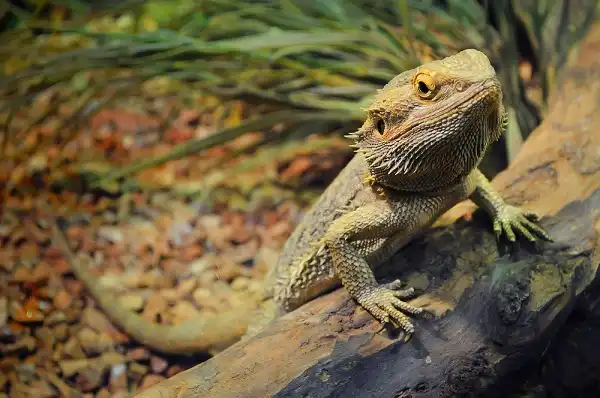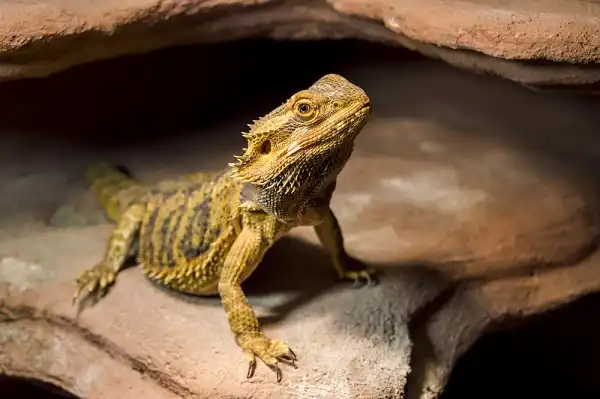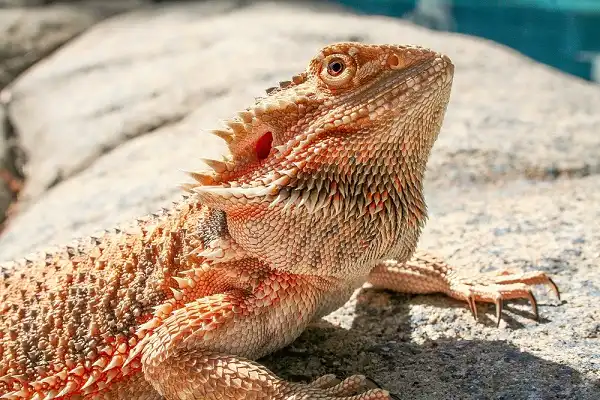Are you looking for a fun, friendly, and unique pet to add some character to your home? If so, consider a bearded dragon! These lovable reptiles are an ideal addition to any family as they’re full of personality and surprisingly easy to take care of. Whether you plan on getting one for yourself or introducing it into the home with kids, there are plenty of benefits that come with having a bearded dragon around. In this blog post, we’ll tell you everything you need to know about caring for your new scaly friend, from what supplies they need to how much attention they require.

Bearded Dragon Description
Bearded dragons have triangular heads, long necks, and slender bodies. Their bodies feature spiny scales that create the iconic “beard” of these animals, which can be raised when they feel threatened or excited. There are many different species of bearded dragons with various colors and patterns on their skin. The most common colors are red, yellow, and orange with some having more subtle variations like blues and greens. Bearded dragons have strong legs that allow them to climb trees and run quickly over sand. They also have sharp claws which help them grip onto surfaces when climbing.
Bearded Dragon Habitat
Bearded dragons are native to Australia’s arid deserts, where they can easily find shelter and food. They usually live in rock crevices, caves, or burrows that provide protection from predators. Bearded dragons also enjoy basking in the sun on rocks or logs, which helps them regulate their body temperature. The ideal habitat should have a range of temperatures from 75-95°F (24-35°C). They need access to both warm and cool areas so that they can choose the most comfortable temperature for themselves.
It is also important to provide humidity levels between 30-50% for optimal health. When setting up a bearded dragon enclosure at home, you should make sure it is spacious enough for them to move around and explore without feeling confined. A 40-gallon tank is generally enough space for one adult dragon, but you may want to go bigger if there is more than one inhabitant. Provide plenty of hiding places as well as objects like rocks or branches that your dragon can climb on.
Bearded Dragon Diet
Bearded dragons are omnivores, meaning they feed on a variety of plants and animals. In the wild, bearded dragons usually eat insects such as crickets, mealworms, wax worms, and cockroaches. They may also consume small lizards, snakes, and rodents. To provide adequate nutrition in captivity, you should feed your dragon a combination of live insects and vegetables. Offer a variety of dark leafy greens such as dandelion greens, turnip greens, collard greens, and mustard greens to ensure your dragon gets enough vitamins and minerals.
You can also provide some fruits like apples or strawberries as occasional treats. Most adult bearded dragons should be fed every other day with an appropriate size food item that is no larger than the width between their eyes. Juveniles should be fed daily to ensure they get proper nutrition for growth. It is important to monitor how much your dragon eats so you can adjust its diet accordingly if needed – overfeeding is not recommended as it can lead to obesity and health problems.

Bearded Dragon Size
Bearded dragons can vary widely in size, depending on the species and age. Adult male bearded dragons usually measure between 16 to 24 inches in length (41-61 cm). Females typically grow to be slightly smaller than males, measuring 14 to 20 inches (36-51 cm). Hatchlings are only about 5-7 inches long (13-18 cm) and weigh around 6-8 grams. As they grow, their weight can increase up to 300 grams or more.
Bearded Dragon Lifespan
Bearded dragons have the potential to live up to 10 years or more in captivity with proper care. This is a fairly long lifespan for a reptile, especially compared to other lizards such as geckos and skinks which only live about 3-5 years on average. However, their exact lifespan can vary depending on factors like diet, environment, and overall health. Good nutrition is essential for a long and healthy life for any pet, but it’s especially important for bearded dragons. Their diet should consist of both animal foods (like insects) and plant-based foods (like leafy greens).
A balanced diet ensures that they get all the nutrients they need for growth and development, as well as the energy to be active. Offering variety here will also help keep their meals interesting and nutritious! Additionally, calcium supplements should be given regularly to promote strong bones and healthy development. The key to helping your bearded dragon live a long life is providing it with an appropriate diet and suitable habitat while ensuring regular vet visits when needed. With these simple steps, you’ll be able to ensure that your scaly friend has an enjoyable life in your home for many years to come!
Bearded Dragon Behavior
Bearded dragons are known for their inquisitive and curious personalities. They generally like to explore their surroundings and will use their long, powerful legs to hop from one spot to another. When they encounter something unfamiliar or new, they will usually inspect it with their snout before deciding whether or not to interact. They can also be quite social and enjoy spending time with people – some may even come up for pets or rub against your hand as a sign of affection! Bearded dragons tend to be fairly active animals and need regular stimulation in order to stay healthy both mentally and physically. This means providing them with plenty of items like rocks and branches for climbing, as well as hiding spots so they can feel secure in their environment. You may also want to offer toys such as chew sticks or paper towel rolls that your dragon can play with which will help keep them entertained and engaged!

Bearded Dragon Speed
Bearded dragons are surprisingly fast creatures, able to move quickly to avoid predators or secure food. In the wild, they can reach speeds of up to 10 mph (16 kph). This is impressive considering their relatively short legs! However, this speed varies from dragon to dragon – some may be faster than others depending on age and health. In captivity, bearded dragons usually move a lot slower than in the wild since there are fewer predators and less need for speed. Adult bearded dragons typically move around at a leisurely pace of about 1-2 mph (1-3 kph), though younger ones may move slightly faster. Also, bearded dragons tend to become more sluggish with age as their mobility decreases due to muscle loss and other age-related issues.
Bearded Dragon Hunting
Bearded dragons are natural hunters and as such, they rely heavily on their acute senses to locate prey. They have excellent vision that allows them to spot potential food sources from far distances. Once they have identified something edible, they will use their long tongues to flick out with lightning speed and snag their target before it can get away. Bearded dragons also have a keen sense of smell that helps them to locate small invertebrates that may be hiding in the sand or under rocks. When hunting, bearded dragons prefer to remain camouflaged so they blend into their environment and avoid detection by predators or prey alike. This is why basking spots play an important role in the wild – it allows them to absorb heat as well as stay hidden while still remaining alert for any movement around them. As soon as something moves within range, they will quickly lunge forward and snatch it up with precision!
Bearded Dragon Reproduction and Breeding
Bearded dragons are relatively easy to breed in captivity, and the process is similar for both wild and captive bearded dragons. They typically mate in the spring, with the female laying clutches of up to 15 eggs over the course of a few weeks. The eggs will then hatch within about two months, usually during summertime. Most female bearded dragons become sexually mature at 12-14 months of age and can lay their first clutch when they reach 18-24 months old. It’s important to ensure that your dragon is healthy before breeding, as any underlying issues can cause problems with fertility or egg production. Male bearded dragons become sexually mature at 8-10 months old and tend to be more aggressive during the mating season due to their natural instinct to protect their territory from other males. To reduce stress during this period, it’s recommended that females be housed separately until they lay their eggs.

Conclusion
Bearded dragons are fascinating lizards that have become popular pet choices in recent years. They make wonderful companions, and with the right care, they can stay active and healthy for many years to come! In this article, we discussed their general behavior and habits as well as information about their diet, hunting techniques, reproduction, and breeding. We hope that you found this guide helpful in learning more about these amazing creatures and better understanding how to properly care for them!
Frequently Asked Question


